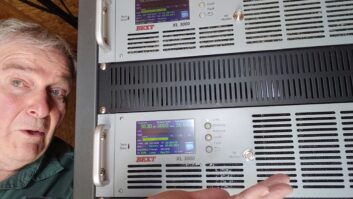In last month�s column, I went over some of the most basic concepts of troubleshooting and ended the article with the repair of a hypothetical transmitter problem. In the real world, problems are rarely that easy to solve.
Let�s look at some advanced troubleshooting concepts.
Sometimes troubleshooting is made easy by obviously burned components, like this RF contactor.

ANALYSIS PARALYSIS
I�ve talked about drilling down to the root cause of a problem when there are several candidates, and said that this is the real art of troubleshooting.
However, there is always the possibility that you can over-think the issue and find yourself wondering just which of many candidates you should examine first. Again, consider Occam�s Razor; when faced with many possibilities, always try to the simplest one first and work your way up to the next most complex (assuming the simplest wasn�t it).
If you find yourself unable to move or take the next step because you have the feeling what you are doing is simply wrong or a waste of time, I have news for you: It could very well be a waste of time. There�s just no getting around that.
So if you find yourself suffering from analysis paralysis, my suggestion is to just try any one of the possibilities. Don�t mull over which is the simplest � just test one. Even if the candidate you investigate doesn�t reveal the real root cause, you might find that it uncovers something else that ultimately helps to solve the problem. Be careful not to let this approach devolve in to a shotgunning process, though (more on that below).
More scorched components. Shotgunning not necessary in this case.

INTERMITTENT PROBLEMS
When a piece of gear just quits working, it isn�t hard to fix (usually). However, when equipment does something odd just occasionally, leaving no concrete evidence behind, it can be very frustrating.
The intermittent nature of some problems can be vexing, but your ability to solve them can distinguish you from your colleagues.
We spend about a quarter of the week actually at work, and far less time than that at remote sites, and so the likelihood that you will be present when an intermittent problem occurs is quite remote. (It would be convenient if gear only acted up in your presence!)
For example, I had a high-power transmitter that would, upon occasion, just drop off the air momentarily. (I should note that it used a vacuum-tube power amplifier.) The good news is that always came back up; the bad news was that the PD kept hearing it, and I never did.
I took the Occam�s Razor approach. The most likely cause, in my estimation, was some issue with the final amplifier tube. So I changed it. At the same time, I inspected the HV blocking capacitor in the final compartment, thinking that was one step above the tube possibility. It looked fine. We put it all back together, and turned it back on. It ran fine for a while, until it dropped off momentarily, again.
The next most likely culprit, based on my experience, was an issue with the high-voltage filter capacitor. So I decided to get a new cap, and I changed it. The transmitter came back up and ran fine for the duration of my tenure. It turns out that cap would intermittently arc inside. The transmitter control circuits are designed to shut down the rig when excess current is drawn, and they worked correctly. The arc was quenched in other words; when it stopped, the rig came back up by itself.
If you have high-power AMs in your portfolio, melted components may very well be familiar to you. Needless to say, spares (like this J-plug) should be kept on-hand.

SHOTGUNNING
Even earlier in my career, I had a transmitter problem similar to the one described above but far worse. The rig would crash overnight, always in the 3 a.m. hour. It pulled its main breaker (on the transmitter), and so it needed to be visited. And every time, I reset the breaker, and it came right back up.
I applied the Occam�s Razor approach based on my prior experience at that point in my career. I changed the tube � no difference. I changed the filter cap � no difference.
At this point, I was starting to get desperate and began �shotgunning� the transmitter (meaning just changing components that could cause the problem, however remote the possibility). This wasted a lot of time and money, and didn�t fix the issue.
It turns out the problem was a faulty circuit breaker � the one I kept resetting. It had just gotten weak. The faulty circuit breaker possibility got added to my Occam�s Razor ladder from that day forward.
Try to avoid the shotgun approach. You will find yourself upon occasion needing to do something, anything, while trying to resolve an issue. But in my experience, more often than not, shotgunning is a waste of resources.
If you can, step back, and let the problem lie dormant for a day or two. Sometimes getting away from it for a brief time helps other ideas come in to your head. This is also a good time (if you haven�t already) to consult colleagues for other ideas.
Next time, we�ll talk about my �induction� technique.
Irwin is the vice president of engineering for iHeartMedia Los Angeles. Contact him at [email protected].












